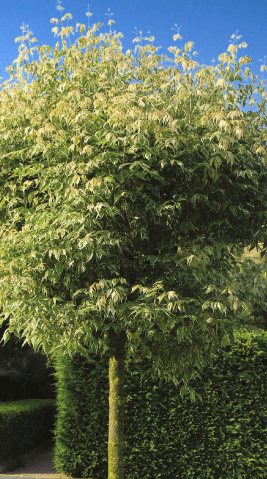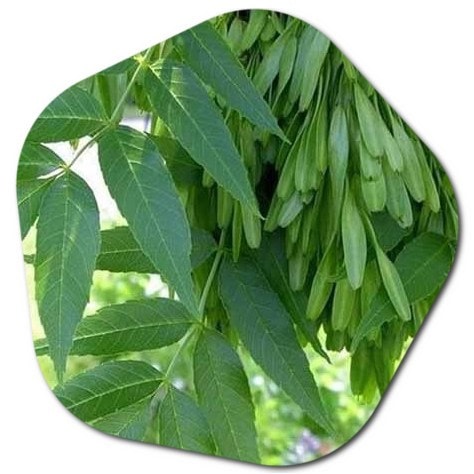What are some interesting facts about Acer negundo?
It grows naturally in North America. It is 15-20 m tall and the crown is 6-8 m wide. It is a round shaped tree. The trunk bark is grayish beige and irregularly cracked. Shoots are light green. Compound pubescent leaves consist of 3-5 leaflets; they are 5-10 cm long and bright green on the upper side. It shows yellow coloration in autumn. Flowers are whitish green and ineffective. It blooms in March and April. Winged fruits are 3-4 cm in size. It grows fast in youth. It grows well on sunny and semi-shady, dry moist, fresh loamy soils. Temperature demand is variable. It is not resistant to floods and wind. It is used as a road tree in the city, in parks and gardens in masses and groups or as a solitary tree.
In landscaping, boxelder is not as commonly selected for ornamental purposes compared to other maple species, primarily due to its rapid growth, relatively unremarkable appearance, and tendency to self-seed abundantly.
What is the description of Acer negundo?
Acer negundo, commonly known as boxelder, boxelder maple, or Manitoba maple, is a deciduous tree or large shrub native to North America. Here is a description of Acer negundo:

- Leaves: The leaves of Acer negundo are compound, typically consisting of three to seven leaflets. Each leaflet is lance-shaped with serrated edges. The leaves are usually bright green in the spring and summer, turning yellow in the fall before dropping.
- Bark: The bark of young boxelder trees is relatively smooth and greenish, gradually transitioning to a grayish-brown color as the tree matures. The bark can become furrowed and rough with age.
- Size: Boxelder is a relatively fast-growing tree that can reach a height of 30 to 50 feet (9 to 15 meters) and a similar spread. It can take on a shrub-like appearance when grown as a multi-stemmed plant.
- Flowers: In the spring, boxelder produces small, inconspicuous flowers that are typically yellow-green in color. These flowers are borne in clusters.
- Fruit: The fruit of Acer negundo is a paired samara, often referred to as “helicopter seeds” due to their winged structure. These seeds are typically light green and mature to a brown color. They are dispersed by the wind.
- Habitat: Boxelder is adaptable and can be found in a variety of habitats, including riverbanks, floodplains, and disturbed areas. It is often considered a pioneer species, capable of colonizing open or disturbed sites.
- Fall Color: While the fall foliage of boxelder is not as vibrant as that of some other maples, it does take on a yellow or yellow-green color before leaves drop in the autumn.
- Tolerance: Acer negundo is known for its tolerance to a wide range of growing conditions, including poor soil, urban pollution, and even periods of drought.
- Invasive Potential: Boxelder can sometimes be considered invasive in certain regions due to its ability to spread rapidly in disturbed areas. Its ability to produce numerous seeds and tolerate a variety of conditions contributes to this.
- Cultivars: There are cultivars of Acer negundo that have been developed for specific characteristics, such as ‘Flamingo,’ which has pink and white variegated leaves.
It’s important to note that while boxelder can be used as a shade tree in some landscapes, it is not as commonly planted for ornamental purposes as some other maple species due to its rapid growth and tendency to self-seed. In some regions, it is primarily considered a weed tree, while in others, it may serve as a useful and adaptable tree for certain landscaping situations.
What is the use of Acer negundo?
Acer negundo, commonly known as boxelder, boxelder maple, or Manitoba maple, has limited practical and ornamental uses, primarily due to its rapid growth and relatively unremarkable appearance. However, it does have a few potential applications and uses:

- Shade Tree: In some cases, boxelder is planted as a fast-growing shade tree. It can provide a relatively quick source of shade in landscapes, making it suitable for areas where rapid growth is desired.
- Wildlife Habitat: The seeds of boxelder are a food source for various birds and small mammals. The tree can provide habitat and forage for wildlife.
- Erosion Control: Due to its tolerance for various soil types and its rapid growth, boxelder can be used for erosion control on slopes or in areas where soil stabilization is needed.
- Firewood and Timber: The wood of boxelder is sometimes used for firewood and, to a lesser extent, for timber in certain regions. However, it is not as highly prized as the wood from some other maple species.
- Pioneer Species: Boxelder is considered a pioneer species, and it can be used in ecological restoration projects to colonize open or disturbed areas, where it helps to prevent soil erosion and prepare the ground for other species to establish.
It’s important to note that Acer negundo is not typically chosen for ornamental purposes in landscaping because it has several drawbacks, including a somewhat weedy appearance and a tendency to self-seed prolifically. In many cases, other maple species are preferred for their more attractive features and growth habits. While boxelder may have its uses in specific situations, it is not a commonly cultivated or highly valued tree in horticultural and landscape design.
Homeland of the Acer negundo tree?
Acer negundo, commonly known as boxelder, is native to North America. Its homeland, in terms of its native range, includes various regions of the United States and Canada. Boxelder is found in the eastern, central, and western parts of North America, making it a widely distributed native species on the continent. Its native range covers areas such as the eastern United States, eastern Canada, the Great Plains, the Mississippi River basin, and parts of western North America. This tree is well-adapted to a variety of habitats, from wetlands and riparian zones to upland areas, and it can tolerate different soil types and growing conditions within its native range.
Information about the Acer negundo tree
Acer negundo, commonly known as boxelder, is a deciduous tree or large shrub native to North America. Here is a brief overview of this tree:
Appearance:
- Leaves: Boxelder has pinnately compound leaves with three to seven leaflets. The leaves are serrated and typically bright green, turning yellow in the fall.
- Bark: The bark is initially smooth and greenish, becoming grayish-brown and developing furrows as the tree matures.
- Size: It is a fast-growing tree, reaching a height of 30 to 50 feet (9 to 15 meters) with a similar spread.
Flowers and Fruits:
- In the spring, boxelder produces small, inconspicuous yellow-green flowers. These are followed by paired winged seeds, known as samaras or “helicopter seeds.”
Habitat:
- Boxelder is adaptable and can be found in various habitats, including riverbanks, floodplains, and disturbed areas. It can grow in a wide range of conditions.
Uses:
- While not commonly planted for ornamental purposes, boxelder is sometimes used as a fast-growing shade tree, for erosion control, and as a pioneer species in ecological restoration projects.
- It is not a highly prized timber tree but can be used for firewood.
Toxicity:
- The seeds and foliage contain hypoglycin A, which can be toxic if ingested by humans, animals, or livestock.
Invasiveness:
- In some regions, boxelder can become invasive, particularly in disturbed areas, due to its rapid growth and prolific self-seeding.
In landscaping, boxelder is not as commonly selected for ornamental purposes compared to other maple species, primarily due to its rapid growth, relatively unremarkable appearance, and tendency to self-seed abundantly.





